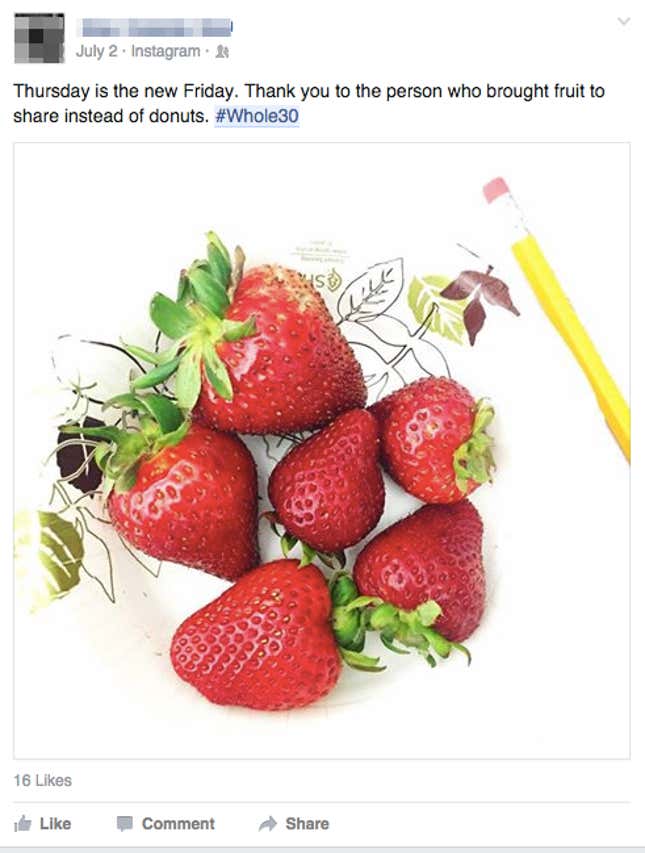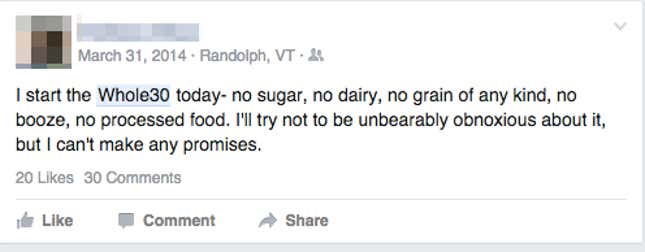
People will basically torture themselves in the name of getting slim. But you can’t call it the Torture Diet. So they call it “Paleo” or a “Juice Cleanse,” and bolster it with gimmicky claims about how it’s going to rid your body of toxins and make you a better, healthier, more spiritually balanced person. But in the end, all of these diets are just ways to get temporarily skinnier, and they don’t really work beyond that.
For several years there, the Paleo Diet was the diet. But it’s just a trend, and thus was destined to eventually give way to a better, faster, more Instagram-friendly way to hit your target weight. The latest of these is the Whole30, a high-protein, no-carb diet that’s more extreme than its caveman-oriented predecessor. But don’t be deluded by a different name and a novel set of dietary restrictions: It’s just another fad like the rest of them.
The Whole 30 is based off the book It Starts With Food by Dallas and Melissa Hartwig, and it requires that you swear off all dairy, grains, legumes, soy, alcohol, sugar, and processed food for 30 days. It’s highly restrictive, in that if you so much as screw up by putting a touch of milk in your coffee, you’re supposed to go all the way back to Day One. It’s huge on social media, and especially Instagram.
There alone, #Whole30 has more than a million posts; #Whole30Challenge has 60,000, #Whole30Approved has 48,000, and other hashtags like #Whole30Breakfast and such have tens of thousands of posts each. That’s a lot of Valencia-tinted ’Grams of random people’s more-extreme-than Paleo meals. Earlier diet fads benefitted from this, too—#Paleo boasts more than 5 million posts, and #WeightWatchers has upwards of a million. It’s where dieters go for support. That’s great, but it doesn’t make the actual diet a good diet.
Although the Whole30 forces you to cut out alcohol, it sounds like coping with this diet inevitably drives you to drink. “We cheated and started drinking wine after like 10 days,” my friend Windsar told me. “You’re supposed to start over, but we didn’t. I lost like eight pounds and gained it back when I started eating carbs again.”

That’s a pretty common thread with a trendy diet that asks you to get rid of some specific type of food for a specific amount of time. (Same goes for Atkins, which restricts carbohydrates.) I spoke to registered dietician Julia Driggers, who backed this up.

“Nowadays in the ‘quick fix’ culture, we tend to gravitate towards following an XYZ diet rather than actually having to think about it ourselves,” she told me via email. “I often use this example when explaining weight loss counseling ... I can place a bowl of ice cream and a bowl of fruit in front of a patient. I then ask, ‘Which option do you think is the healthiest for dessert?’ Nine times out of 10, the patient knows the fruit is a better option, but chooses the ice cream. The real therapy starts when we begin discussing the reason why someone chooses the unhealthy option over the healthy. This type of behavioral modification does not come from one month of extreme dieting.”

So just because you aren’t eating sugar or dairy or whatever for a month, that doesn’t mean you’re going to see long-term results. In fact, Driggers said fad diets have been linked to excessive weight-gain after the fact. “In general, if a person has a rapid weight loss over a period of weeks, when their old eating habits return, they can end up weighing more than their weight prior to the fad diet!” she wrote. “It’s a vicious cycle.”

Bottom line: It doesn’t matter what you do for a month. Eventually, you’ll return to your old habits and gain the weight back. If you really want to get fit, you have to eat a balanced diet, exercise, and more or less permanently change your lifestyle.
The weight-loss industry is huge, of course—$60 billion a year huge, with much of that revenue dependent on starter texts and cookbooks and meal plans and whatnot. It Starts With Food is only the latest best-seller. It’s only loosely based in science, though: It espouses all kinds of benefits (better sleep, higher levels of energy, etc.) that are inherently subjective and more or less impossible to actually measure. Excising healthy foods like yogurt and legumes doesn’t seem too smart, either.
But that doesn’t mean people aren’t finding success with Whole30. My friend Anthony talked to me on Day 15, and he was doing great. “In the past, when I’ve said I’m starting some new diet, I’ve lost all willpower by hour four,” he told me. “It just felt too restrictive. But with this one—I think because of the fact that I can eat, and as much as I want (within reason) until I feel full, and because of how good I feel eating real food—it will probably be something I try to keep up with long term.”
The long-term thing is key: You have to treat it less like a diet and more like a philosophical lifestyle change. But you don’t need a book or a trend diet to do any of that. Stop drinking so much beer. Go on a run a couple times a week, or just walk more. Eat more vegetables. Try a new diet or try cooking better. Take care of your body. You don’t have to follow Paleo or Atkins or South Beach or People’s Temple or Whole30 to do that. You don’t even need social media.
Top illustration by Jim Cooke